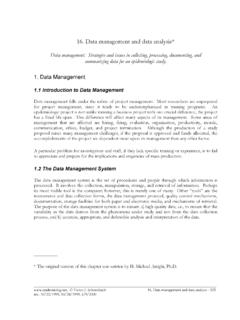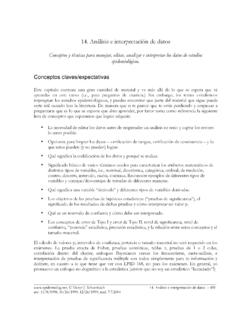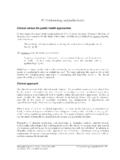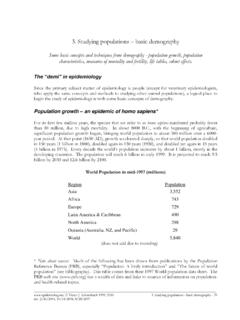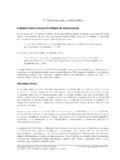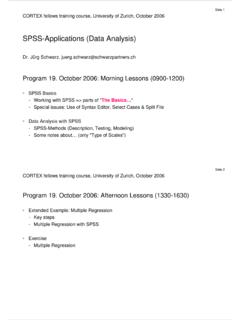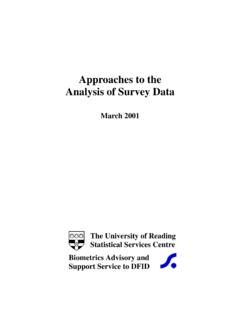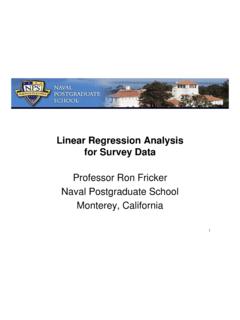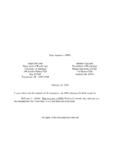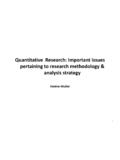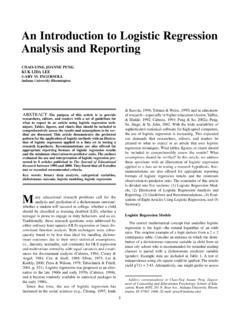Transcription of Data analysis and interpretation - epidemiolog.net
1 14. data analysis and interpretation Concepts and techniques for managing, editing, analyzing and interpreting data from epidemiologic studies. Key concepts/expectations This chapter contains a great deal of material and goes beyond what you are expected to learn for this course ( , for examination questions). However, statistical issues pervade epidemiologic studies, and you may find some of the material that follows of use as you read the literature. So if you find that you are getting lost and begin to wonder what points you are expected to learn, please refer to the following list of concepts we expect you to know: Need to edit data before serious analysis and to catch errors as soon as possible.
2 Options for data cleaning range checks, consistency checks and what these can (and can not) accomplish. What is meant by data coding and why is it carried out. Basic meaning of various terms used to characterize the mathematical attributes of different kinds of variables, , nominal, dichotomous, categorical, ordinal, measurement, count, discrete, interval, ratio, continuous. Be able to recognize examples of different kinds of variables and advantages/disadvantages of treating them in different ways. What is meant by a derived variable and different types of derived variables. Objectives of statistical hypothesis tests ( significance tests), the meaning of the outcomes from such tests, and how to interpret a p-value.
3 What is a confidence interval and how it can be interpreted. Concepts of Type I error, Type II error, significance level, confidence level, statistical power , statistical precision, and the relationship among these concepts and sample size. Computation of p-values, confidence intervals, power, or sample size will not be asked for on exams. Fisher's exact test, asymptotic tests, z-tables, 1-sided vs. 2-sided tests, intracluster correlation, Bayesian versus frequentist approaches, meta- analysis , and interpretation of multiple significance tests are all purely for your edification and enjoyment, as far as EPID 168 is concerned, not for examinations. In general, I encourage a nondogmatic approach to statistics (caveat: I am not a licensed statistician!)
4 _____. Victor J. Schoenbach 14. data analysis and interpretation 451. rev. 6/27/2004, 7/22/2004, 7/17/2014. data analysis and interpretation Epidemiologists often find data analysis the most enjoyable part of carrying out an epidemiologic study, since after all of the hard work and waiting they get the chance to find out the answers. If the data do not provide answers, that presents yet another opportunity for creativity! So analyzing the data and interpreting the results are the reward for the work of collecting the data . data do not, however, speak for themselves . They reveal what the analyst can detect. So when the new investigator, attempting to collect this reward, finds him/herself alone with the dataset and no idea how to proceed, the feeling may be one more of anxiety than of eager anticipation.
5 As with most other aspects of a study, analysis and interpretation of the study should relate to the study objectives and research questions. One often-helpful strategy is to begin by imagining or even outlining the manuscript(s) to be written from the data . The usual analysis approach is to begin with descriptive analyses, to explore and gain a feel for the data . The analyst then turns to address specific questions from the study aims or hypotheses, from findings and questions from studies reported in the literature, and from patterns suggested by the descriptive analyses. Before analysis begins in earnest, though, a considerable amount of preparatory work must usually be carried out.
6 analysis - major objectives 1. Evaluate and enhance data quality 2. Describe the study population and its relationship to some presumed source (account for all in-scope potential subjects; compare the available study population with the target population). 3. Assess potential for bias ( , nonresponse, refusal, and attrition, comparison groups). 4. Estimate measures of frequency and extent (prevalence, incidence, means, medians). 5. Estimate measures of strength of association or effect 6. Assess the degree of uncertainty from random noise ( chance ). 7. Control and examine effects of other relevant factors 8. Seek further insight into the relationships observed or not observed 9. Evaluate impact or importance Preparatory work data editing In a well-executed study, the data collection plan, including procedures, instruments, and forms, is designed and pretested to maximize accuracy.
7 All data collection activities are monitored to ensure adherence to the data collection protocol and to prompt actions to minimize and resolve missing _____. Victor J. Schoenbach 14. data analysis and interpretation 452. rev. 6/27/2004, 7/22/2004, 7/17/2014. and questionable data . Monitoring procedures are instituted at the outset and maintained throughout the study, since the faster irregularities can be detected, the greater the likelihood that they can be resolved in a satisfactory manner and the sooner preventive measures can be instituted. Nevertheless, there is often the need to edit data , both before and after they are computerized. The first step is manual or visual editing . Before forms are keyed (unless the data are entered into the computer at the time of collection, , through CATI computer-assisted telephone interviewing) the forms are reviewed to spot irregularities and problems that escaped notice or correction during monitoring.
8 Open-ended questions, if there are any, usually need to be coded. Codes for keying may also be needed for closed-end questions unless the response choices are precoded ( , have numbers or letters corresponding to each response choice). Even forms with only closed-end questions having precoded responses choices may require coding for such situations as unclear or ambiguous responses, multiple responses to a single item, written comments from the participant or data collector, and other situations that arise. (Coding will be discussed in greater detail below.) It is possible to detect data problems ( , inconsistent or out of range responses) at this stage, but these are often more systematically handled at or following the time of computerization.
9 Visual editing also provides the opportunity to get a sense for how well the forms were filled out and how often certain types of problems have arisen. data forms will usually then be keyed, typically into a personal computer or computer terminal for which a programmer has designed data entry screens that match the layout of the questionnaire. For small questionnaires and data forms, however, data can be keyed directly into a spreadsheet or even a plain text file. A customized data entry program often checks each value as it is entered, in order to prevent illegal values from entering the dataset. This facility serves to reduce keying errors, but will also detect illegal responses on the form that slipped through the visual edits.
10 Of course, there must be some procedure to handle these situations. Since most epidemiologic studies collect large amounts of data , monitoring, visual editing, data entry, and subsequent data checks are typically carried out by multiple people, often with different levels of skill, experience, and authority, over an extended period and in multiple locations. The data processing procedures need to take these differences into account, so that when problems are detected or questions arise an efficient routing is available for their resolution and that analysis staff and/or investigators have ways of learning the information that is gained through the various steps of the editing process.
